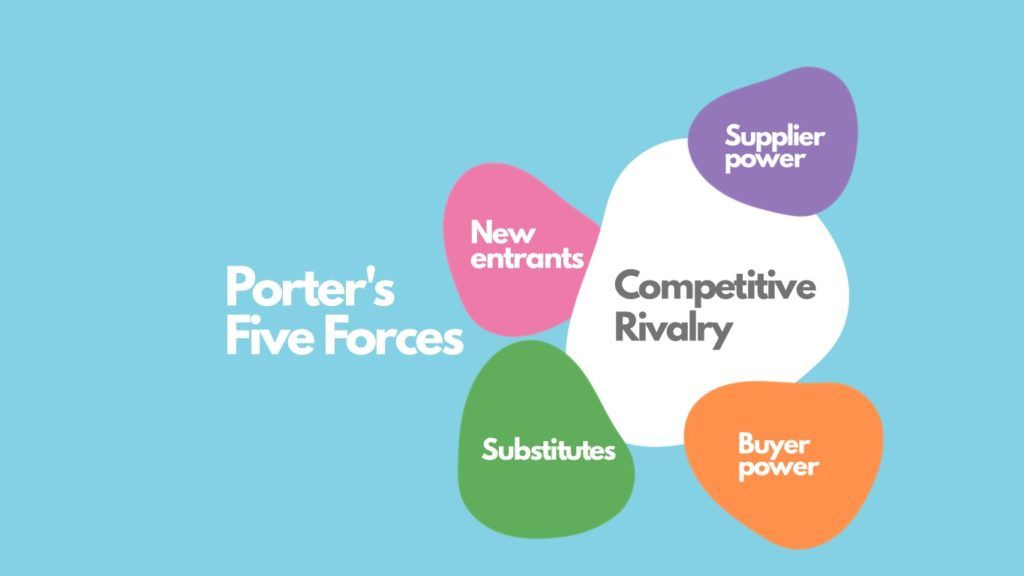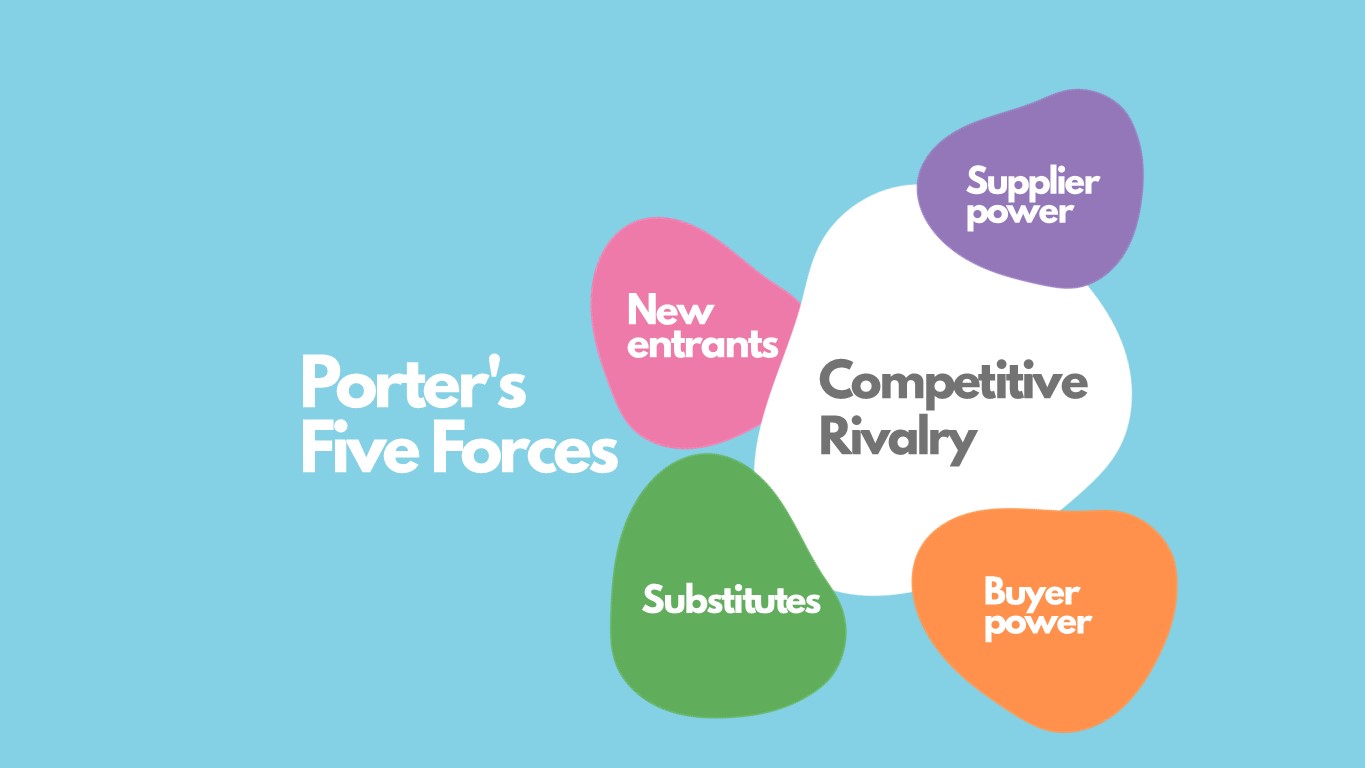Porter’s concept of the ‘five forces’ is one of the most important topics within strategy literature. This model has changed how we look at the profitability of the firms. The model is simple, it is frugal and easy to use. Here we will explain Porter’s 5 forces that shape competition. Additionally, we shall discuss how it is relevant today and what are the shortcomings of this model.
Contents
Michael Eugene Porter

Prof Michael Eugene Porter is a professor at Harvard Business School. His work is now an indispensable part of MBA courses across the world. Porter’s five forces model is one of his most notable works.
In fact, he has been awarded the best HBR article of the year over six times. He is also one the most cited authors in management with over 537k citations(in May 2020). To put things into perspective: a professor with over 10k citations in managment areas is considered an expert in their field.
He was interviewed for a book in 2010. He discussed his distinguishing ability to take a fairly complex problem and reconceptualize it as simple easy to understand the model. The model that we discuss here is one such model, albeit the most popular one.
Strategy before ‘Porter’s five forces’

One of the important performance indicators for any business is ‘profitability.’ It is quite natural that competitors force a firm to lower the prices hence lower the profitability. Hence, it was thought that competition was merely ‘a tussle’ between business rivals. However, Porter wrote a revolutionary HBR article in 1979. He argued that the competition was viewed too narrowly. He proposed that there were more factors that decided on a firm’s profitability. In addition to the obvious competition due to business rivals, there were four more forces at play.
The five competitive forces that shape strategy
He posited that firms operate under constant pressure from many different stakeholders. These stakeholders want to maximize their value. For example, one stakeholder is the customer. Customers want to buy the product as cheaply as possible. This creates competition among the producers to deliver the product as cheaply as possible.
The approach that Porter suggests gives us a wider perspective to look at the firm. It is a simple but powerful model. A model that can help predict which industries would be more profitable. However, there are certain flaws in this approach. We shall discuss them towards the end of this article.

Threat of new entrants
One of the biggest threats a firm can face is from new entrants. New entrants are firms that are either startups or established firms that extend themselves into a new industry. New firms are hungrier for growth. They are agile and can adapt faster than older firms. The older firms that are already operating in an industry are also known as incumbent firms.
However, not all businesses have the same level of threat of new entrants. It is easier to start a business in some industries while it is difficult in another. Above all, an industry, where one can start a business faster and cheaper, is considered an easier one to enter. Therefore, we can say that the threat of entry is higher. We shall have a more nuanced discussion about other parameters to judge the threat of new entrants in the section below.
The threat of new entrant is complementary to ‘barriers of entry’
Another way to look at the threat of new entrants is by flipping the side. An industry that has a higher threat of new entrants means anyone can start a business easily. In other words, the industry has lower entry barriers. If we consider services like babysitting, anyone can enter the market and start a service.
| Low threat | High threat |
|---|---|
| Telecommunication | Professional services |
| Petrochemical industry | Scientific services |
| Transportation | Food and beverages |
| Wholesale trading | Retail trade |
| Manufacturing | Technical services |
| Pharmaceuticals | Website & Web-services |
| Airline industry | Laundromats |
An industry with a lower threat of new entrants is ideal. For instance, consider a petrochemical refinery. Firstly, t would cost millions to set-up a refinery. It would also take several years to get established. Secondly, the refinery business would require a strong industrial network to acquire raw material. Furthermore, it would also be difficult to establish a relationship with buyers.
Managing the “threat of new entrants”?
Controllable factors
There are certain factors that can make it easier or difficult for a new entrant. Therefore, some of these barriers can be controlled by the firm. A manager is expected to make these barriers stronger/higher.
- Brand loyalty: If there is higher brand loyalty, it will be more difficult for a new entrant to capture your market share.
- Using the 4Ps effectively: It is a powerful tactic used by incumbents. An example: an FMCG market leader has a 40% market share in toothpaste. Subsequently, They suddenly find a new competitor which sells a new toothpaste for people with sensitive teeth. The incumbent FMCG firm can employ a variety of techniques to counter this:
| Approach | Action |
|---|---|
| Product | introduce a new toothpaste for sensitivity |
| Price | provide an offer a or a discount |
| Place | ensure a better presence in the retail outlets by incentivizing the retailers |
| Promotion | promote the new product and/or it’s toothpaste brand |
- Data Analytics: The incumbents usually have access to richer data that they can use to their advantage to counter the new entrant. Data analytics can easily give a competitive advantage over the new entrant.
- Cost game: Incumbents also have better access to resources. They can scale up faster and generally, the fixed costs are lower if they have been operating for a few years. It is easier and less costly for the incumbents to offer discounts or bundle other products.
- Intellectual property:
- Cartelization and Collusions: There are also some unethical or even illegal ways to counter the new entrant. Incumbent companies can collude together and create a cartel. They can together decide to reduce the cost to such a low value that no one buys the product from new entrants. Alternatively, they can use their relationship with wholesalers or stockists to flood the market with their product. There are many such ways to ensure that the new entrant shuts their business due to the losses.
Uncontrollable factors
On the other hand, there are many factors that are either difficult to control or totally uncontrollable. A manager has little control over these factors.
- Government regulation: Certain industries require licenses to operate. Certainly, it takes time, money, credentials, and connections to get a license or permission.
- Tax: Some governments may tax imports of foreign-made goods. Such measures are called protectionism.
- Incumbent & New-entrant interplay: This one is very interesting. One can never know how their competitors will react. The incumbents can react very differently. Even though they retaliated because of the new entrant that can cause harm to other incumbents too. Some industries have fierce battles that last for years(search about Pepsi vs Coca-Cola; Intel vs AMD)
Bargaining power of suppliers
Seasoned managers understand the value of suppliers. Certainly, suppliers hold immense power. Power to negotiate a deal to their advantages like charging a higher price, forcing long term contracts, bundling goods, or cross-selling other products. They shape a firm’s operations, marketing, and financial strategies. The ways in which a supplier can yield power are:
- Control over prices: suppliers can extract higher profit by charging you a higher price. This will impact your bottom line. This would be more effective if there are fewer suppliers. An example is mobile chipset giant Qualcomm which has immense control over the pricing of their Snapdragon chipsets.
- Control over quality: Suppliers can also get into exclusive agreements with companies. A supplier may supply products of different quality standards. As a manager, you may be required to comply with the quality requirements set by your firm. This would narrow down the number of suppliers. If a number of suppliers are lesser, they have more power.
- Service contract: In many sectors, there is more money in service and maintenance than in the manufacturing of products. PC manufacturers can introduce binding clauses or bundle annual maintenance contracts with their products.
- Proprietary technology: certain technologies can increase the switching cost from one supplier to another. Hence, the firm may find it difficult to change the supplier.
- Super specialized products: If a supplier holds a patent for a specific raw material, they will have a higher power. Similarly, a pharmaceutical firm that supplies medicine exclusively.
Managing the suppliers
- Backward integration: Backward integration means acquiring or developing assets to replace a supplier. Consider the case of a restaurant chain. They realize that a major chunk of their raw material costs come from meat. Consequently, they acquire cattle and poultry farms. This would ‘potentially’ reduce their dependence on suppliers.
- Trade deals: Larger firms can outbid other competitors and ensure they get a better deal from the manufacturers.
- Investment: It is difficult to ensure the success of backward integration. Sometimes such measures fail. Another approach is to acquire a stake in the suppliers. As a result, it would increase the power over the supplier.
Bargaining power of buyers
The old adage sums it up: Customer is the king. There are a lot of ways in which the customers can reduce the profitability of the firm. As a result, they impact the top line of the firm. Here are some ways in which they can exhibit their power:
- Pulling down the prices: Customers like saving money. They like lower prices, higher discounts, and other offers.
- Demand for quality: In addition to price, customers are also quality conscious. They would like to have a higher quality product within their desired price.
- Demand for quantity: In the same vein as quality, customers also demand a higher quantity. Customers are happy when they get 20g extra for 100g biscuits.
- Backward integration: B2B customers can also employ another tactic. They can replace you by doing your work.
However, customers are often heterogeneous. In other words, there are different groups of customers who behave differently from one another. Consequently, they will have different levels of power over your firm. As a result, it is paramount to respond to the buyers as one of Porter’s 5 forces.
Managing the buyers
- Expand the market size: if there are few, powerful buyers, they will drive the prices up.
- Product differentiation: creating product differentiation can be helpful. It enhances customer loyalty. Additionally, it improves profitability.
- Increase switching cost: higher switching cost means that the buyers find it difficult to switch to another product. For example, we have Apple Inc. Once a person gets into their ‘eco-system’ of products, they find very difficult to get out.
Threat of substitutes
A substitute product is one that performs the same function as your product. For example, Pepsi is a substitute for Coca-cola. However, substitutes could be less obvious. For instance, milk, water or even juice could be a substitute for Coca-cola.
In the same vein, what are the substitutes for an airline? Obviously, other airlines. However, railways or buses could also be a substitute. Additionally, if we consider a business traveler, Zoom could be a substitute too.
The products and services also bear the risk due to changes at the buyer’s end. Life events, changes in income, preference can lead to switching of product. At times, the threats may be much less obvious like the zoom example. Anand Mahindra, the Chairman of Indian automobile company Mahindra and Mahindra Ltd, made a bold statement. He stated that the biggest threat auto manufacturers face is not from other manufacturers. Ridesharing apps like Uber and Ola are imminent threats to the automotive industry. Therefore it is important to acknowledge the threat of substitutes as an important member of Porter’s 5 forces.
Managing the ‘threat of substitutes’
The threat of substitutes also impacts the top line of a firm. However, the firm can undertake some measures to counter the effect of substitutes:
- The threat of substitutes is lower for products that have a well-defined strategy. A firm may either offer a cost advantage for its products or offer a desirable and distinctive product. That is to say, the success of smartphone brands such as Xiaomi, Vivo, Realme, and Oppo have a common strategy. They both offer higher ‘value for money’ compared to rival brands. Their phones are priced much lower than the competition for the same specification. On the other hand brands like Apple capitalize on the distinctiveness of their product. Alternatively, brands like Oneplus attempt to cater to a specific segment of the market. They position themselves as ‘flagship killer.’ In other words, they want to cater to those users who want the performance of top-end phones but who also want to pay a much lower price.
- Consequently, the firm may adopt a combination of the three strategies defined by Porter in his 1980 book competitive strategy. The three strategies are cost leadership, differentiation strategy, and focus strategy.
- One should also note that differentiation strategy is more suited for larger firms while cost leadership or focus strategies are better for smaller firms. The reason is that in order to offer distinctive products and services, the firm needs expertise in management functions like operations, manufacturing, finance, and marketing.
Real-life examples from the smartphone industry
| Smarphone brand | Strategy | Market share# |
|---|---|---|
| Apple | Differentiation | 24% |
| Samsung | Mixed strategies* | 18% |
| Xiaomi | Cost leader | 8% |
| Oppo | Cost leader | 8% |
| Oneplus | Focus | 2%** |
#Source: Counterpoint Research (Q42019)
** Source: Android Central
*Samsung employs a mixed strategy. For instance, in the premium segment, it attempts to compete with product differentiation by offering phones like Galaxy S series and Note series. In the mid-range, it offers A-series phones. At the lower end, it offers M-series phones which are based on value for money proposition.
Competitive Rivalry
Firstly, let us look at the definition of rivalry: “The strength of competition among the existing(incumbent) firms in an industry.” In other words, it means how fiercely the firms compete against each other.
The rivalry among existing competitors is the fifth of Porter’s 5 forces. We started this discussion with the contribution of Michael Porter. He expanded the narrow vision of the competition. Competitive rivalry is, therefore, the oldest of Porter’s 5 forces.
But how can we know ‘how much’ rivalry is there?
Industry concentration is a strong indicator of competitive rivalry. For example, one of the most popular and reliable measures of industry concentration is the Herfindahl-Hirschman Index (HHI). HHI is measured by the summation of squares of all the market share of firms. Let us say firms Fi have market shares Xi then:
HHI = Σ Xi2
To clarify in plain & simple English: HHI depends on the number of firms and relative size of firms. Firstly, HHI is lower for industries with more number of firms. HHI is also lower for industries with an equal share of the market. Let us consider two extreme cases:
- An industry with 1 firm will have HHI = 1002 = 10,000
- Another industry with 10 firms with 10% share each = 1,000
- Meanwhile an industry with 10 firms. One firm has a 90% market share, other 9 firms have 1.11% market share each. HHI = 8111.11
- Also, another industry with 1000 firms with 0.1% market share each will have HHI= 10
- Consequently, an ideal industry with infinite companies may have HHI that approaches the theoretical minimum value of zero.
Managing the competitive rivalry
- Innovation: Firms can either approach this problem by making innovative things or innovating how firms make, distribute, sell, and communicate things.
The entire business model of Dell was to create a disruptive way of delivering personal computers. Consequently, it was the first firm that attempted to deliver PCs as per customer order, direct to home. It helped it reduce operating, warehousing, and showrooming costs. As a result, they passed on the cost savings to the customer.
On the other hand, the resurgence of Apple Inc was largely based on the innovative way they presented their iPods. Its focus was on making the mp3 player easy to use. They also innovated in communicating. Their competitors were busy highlighting technical features. On the other hand, Apple focused its communication to convey one simple message: “carry 1000 songs in your pocket.” - Leveraging the network platforms: Modern businesses are set up upon platforms that connect the businesses and consumers. Airbnb connects potential travelers with room owners, Uber connects ride takers with the cab drivers, and Amazon connects the buyers with the sellers. There is a much higher cost of switching networks for consumers as well as producers. Hence, these kinds of platforms offer an immense competitive advantage for the firms.

Criticism of Porter’s five forces
The biggest criticism of Porter’s five forces is that it is a ‘model.’ Models are simply a way of arranging information. Unlike ‘theories’ they cannot be verified. Theories can predict and explain a phenomenon because they have been tested ’empirically.’
Here are other common criticisms of the Porter’s 5 forces:
- Some people have pointed out that a lot has changed since 1979. The world is much more connected, globalized, and digitalized. External environments are highly dynamic today, compared to almost four decades ago.
- Porter’s 5 forces look into a ‘snapshot’ of data. In an ever-changing world, it may be prudent to take the analysis with a grain of salt. For instance, let us say we have market share data for smartphones from Q4 of 2019 and we are sitting in Q2 of 2020. Can we really rely on that data to assess the competitiveness of the industry?
- It cannot model the uncertainties associated with a crisis like Covid-19. Therefore, the predictions of Porter’s five forces are often invalidated. Sometimes at much smaller turmoils in the market.
- Another limitation of Porter’s 5 forces is that it is highly limiting in terms of its definition for the industry. Modern firms can straddle between different industries. Amazon has an intricately woven network of e-commerce, cloud, and Webservice business units.
- Prone to blindspots. On one hand, we have a higher tendency to commit mistakes like omitting a competition or substitute in our analysis. On the other hand, it can give an overly optimistic picture. If we consider the case of Fujifilm, the camera manufacturer. If they only include products from other brands like Nikon, Canon, and Sony they may not be able to predict the true level of competition. Their biggest competitors maybe android and iOs smartphones.
- Regulations create massive imbalances. Firstly, government regulations can highly offset the effect of Porter’s 5 forces, making it less useful. Secondly, many developing countries have very strong taxation and subsidies for specific firms. These can turn a seemingly profitable firm into a nightmare very fast.
- Dependence on qualitative data and subjective assessment: One common underlying pattern in this model is that it mostly is driven by qualitative data. Secondly, it depends heavily on the analyst(which is due to the subjectivity). One person may say that buyers of iPhones have low bargaining power. They buy anything thrown at them at any price. Apple Inc removed the headphone jack and forces the buyers to buy the overpriced earbuds. Another person may say that buyers have immense power because the dip in sales due to the increase in price made the firm bring back the lower-priced model iPhone SE.
FAQs for Porter’s five forces
Threat of new entrants
Bargaining power of buyers
Threat of substitutes
Bargaining power of suppliers
Rivalry among existing competitors
It enables a wider view of the competition to understand what factors influence the profitability in an industry. Porter’s five forces is a simple and frugal model to get an overview of the industry.
Michael Eugene Porter developed Porter’s five forces. He is a distinguished professor at Harvard Business School.
The first criticism is that it is just a model hence, not backed by data. Secondly, industries considered to be unprofitable by five forces still have many profitable firms. Thirdly, it assumes customers are not the main part of the business process. Fourthly, Porter divides the strategy into two buckets of Generic vs Distinct. This black & white distinction may not be correct.
One common mistakes made in using the Porter’s model is to apply it to companies rather than industries. The results of the analysis is indeed a great tool to understand the forces in an industry. However is is not very good indicator for firm level performance.
Yes, Porter’s five forces are still applicable. Disruptive forces like globalization, digitalization and platforms have diminished the value of the insights. However, it is still a fast and easy to use tool to get an overview of the competition in an industry.
The Porter’s 5 forces determine the intensity of competition in an industry. Firms where these five forces are stronger have higher level of competition hence lower level of profitability.
The best use of Porter’s five forces is understand and strategize for entry into an industry. It is useful for startups as well as venture capitalists.
Michael Porter published his article on the five forces that shape strategy in 1979 issue of HBR.
We share a lot of quality content daily. All our articles are free. We request you to share this content if you found it to be useful. It really helps us a lot. Thank you.

The best article I read about 5 forces! Thank you.
Sincerely thank you for taking time to comment. I am glad you liked the article.
This was absolutely my best read on Porter’s 5 forces, well detailed and encapsulating. Thank you for taking time to share this information. Cheers!